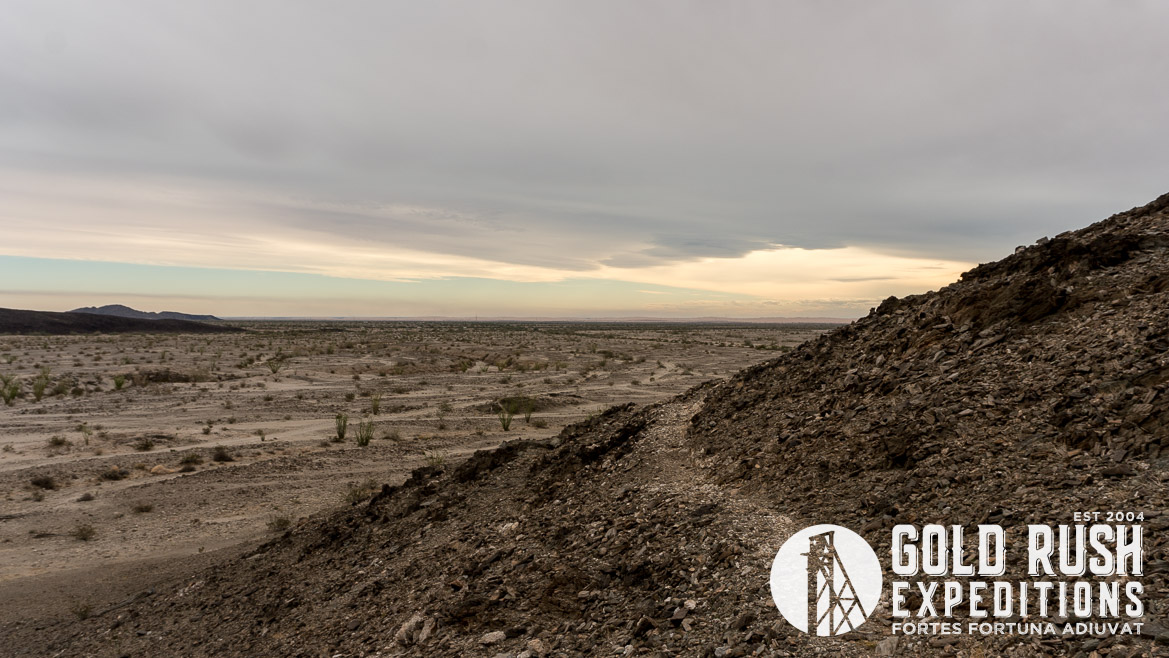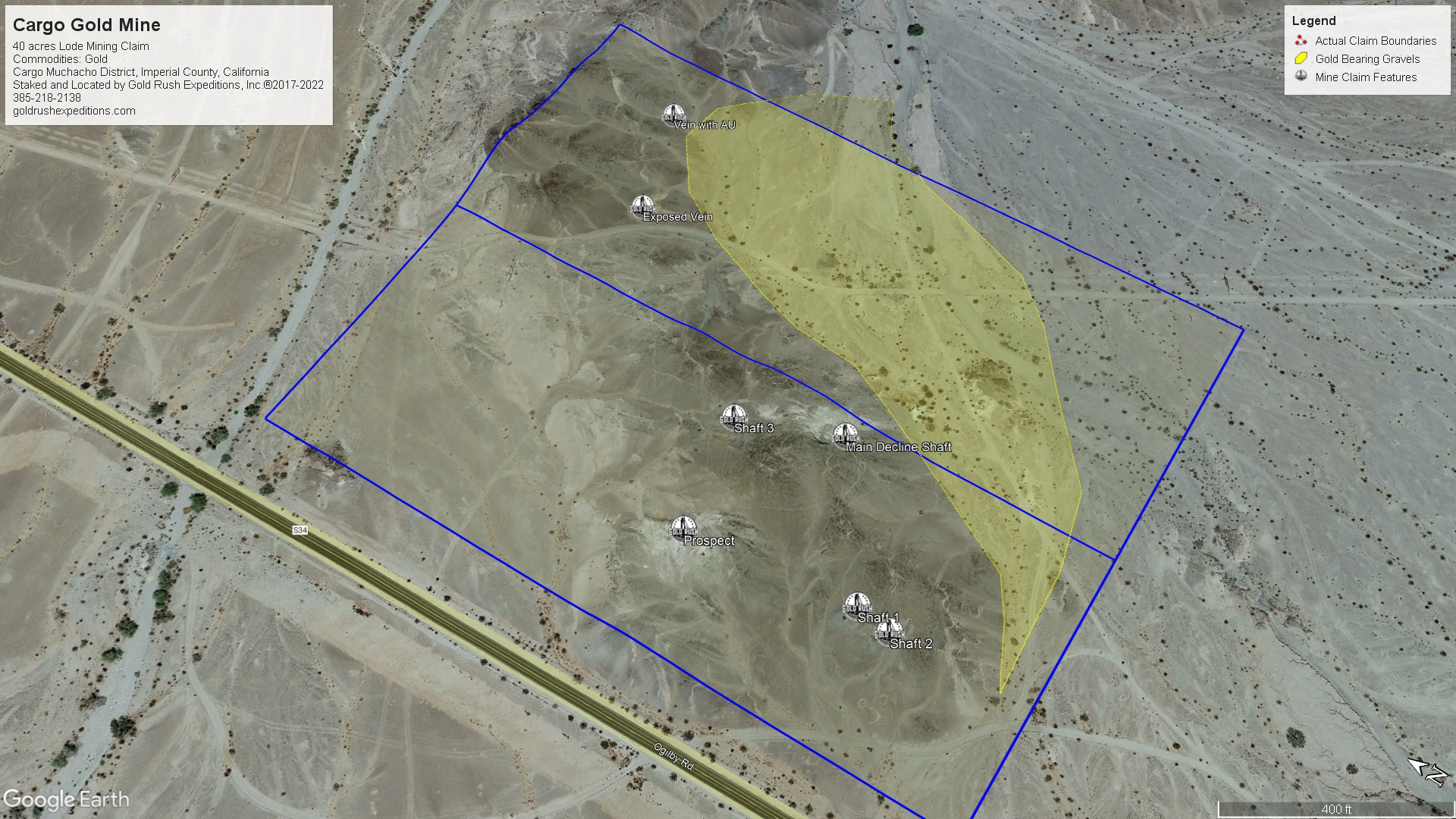



Sold
Click to read more...
Property Overview
The Cargo Mine is located in the low western hills of the Cargo Muchacho Mountains. The site was reclaimed by the state of California in 2002, and the two main shafts were plugged with PUF. This does not affect any mining rights or permits. It is fully permissable to remove the plugs and restore the underground access at the site.
On the surface at current, there is much of the quartz and pyrite material left from the dumps that were pre-existing on the site. This material carries an average of .478 oz. per ton in gold. There are two shafts and numerous prospects that expose the surface veins of quartz and gold. The Cargo Mine is located west of the patented Tumco Property which has been worked, over and over again.
The gold in the Cargo Muchacho mountains is well known and has a long history. Gold mining began in the Cargo Muchacho region in 1660 but lasted only a short time. Originally known as the Sierra de San Pablo, the Cargo Muchachos were first described by Spanish explorer Father Francisco Garcis, who recorded rich looking surface ore in 1776.
In 1858 American and Mexican miners encountered placer deposits in the Cargo mountain area. Work included around 350 Mexicans and only five “Americans.” Jose Maria Mendivil and a man named Valenzuela made strikes at Picacho in 1861 where Mexican families were already prospecting. Rich placer deposits were discovered at La Paz, 60 miles north of Yuma, by Jose Maria Remodino in 1862. Mexican prospectors recovered gold from the arid sands using dry washing techniques developed in Sonora. Caution and hostility that resulted from their Northern California experience makes accurate documentation of their activities difficult. They seldom recorded mining claims or discussed their finds with non-Hispanic “Gringos.”
First established in 1862, the Cargo Muchacho Mining District was redefined several times in later years. Continued small scale prospecting and mining characterized the 1860s and 1870s. The inhospitable environment and limited access retarded development of the region. As previously noted, this area contained rich surface ores mined by Spanish colonists in the 1780s and Mexican prospectors in the 1850s.
Evidence exists that Mexican miners also worked in the Cargo Muchachos at this time, digging shallow pits by hand and processing the ore in arrastras. In 1891, a visitor to the Madre Valley noted that “…many acres have been burrowed by the [former] Mexican miners, who, digging down until they almost stood on their heads were compelled to be satisfied and quit.” It may have been during this period that the mountains received their present name. According to legend, two young Mexican boys came into their family’s camp one evening with their shirts filled with gold ore. These muchachos cargados (loaded boys) became the namesake for the Cargo Muchacho range. Another version says the boys found gold while looking for horses that had strayed from an immigrant party on their way to Los Angeles in 1861.
The Cargo Mine is one of the first deposits mined in Imperial County. The deposit was located in 1877 by Thomas Porter Neet, and by 1882, 14,000 tons of ore had been mined which averaged $12 per ton. The mine was surveyed for patent in 1892. Other periods of major activity were 1890-1894 and 1936- 1942, 1949-1952. Total production probably exceeds 25,700 ounces of gold. The mine is developed by a 680-foot inclined shaft at the north end of the vein, and a 200-foot vertical shaft about 1100 feet south of the deep shaft. Most of the stopes are below the third level. The area as far north as 800 feet of the main shaft was explored on the surface by several shallow shafts. In another prospect a 125-foot adit was driven due north from a point 1000 feet N 70 degrees W of the main shaft.
The Cargo Mine gold deposit is believed to be a detachment-fault-related gold deposit consisting of replacement mineralization along a low-angle detachment (listric) fault related to an extensional fault system in the Cargo Muchacho Mountains. Mineralization is hosted wholly within the Tumco Formation.
Mesothermal mineralization occurs in multiple brown to brownish gray siliceous zones containing hematite, magnetite, quartz, mica, feldspar, chlorite, and blue copper oxides. Native gold containing very low silver is associated with iron oxides. Most gold is very fine with ±64% <1 to 5 microns in size. No significant toxic elements are present as are found in epithermal deposits. The “ore” is considered inert.
Gold Rush Expeditions, Inc. does offer mining consultation services and assistance with permits for a small fee.
Training courses for underground work and exploration can be found here: https://stayoutstayalive.com/training/
The Cargo Mine is located in the low western hills of the Cargo Muchacho Mountains. The site was reclaimed by the state of California in 2002, and the two main shafts were plugged with PUF. This does not affect any mining rights or permits. It is fully permissable to remove the plugs and restore the underground access at the site.
On the surface at current, there is much of the quartz and pyrite material left from the dumps that were pre-existing on the site. This material carries an average of .478 oz. per ton in gold. There are two shafts and numerous prospects that expose the surface veins of quartz and gold. The Cargo Mine is located west of the patented Tumco Property which has been worked, over and over again.
The gold in the Cargo Muchacho mountains is well known and has a long history. Gold mining began in the Cargo Muchacho region in 1660 but lasted only a short time. Originally known as the Sierra de San Pablo, the Cargo Muchachos were first described by Spanish explorer Father Francisco Garcis, who recorded rich looking surface ore in 1776.
In 1858 American and Mexican miners encountered placer deposits in the Cargo mountain area. Work included around 350 Mexicans and only five “Americans.” Jose Maria Mendivil and a man named Valenzuela made strikes at Picacho in 1861 where Mexican families were already prospecting. Rich placer deposits were discovered at La Paz, 60 miles north of Yuma, by Jose Maria Remodino in 1862. Mexican prospectors recovered gold from the arid sands using dry washing techniques developed in Sonora. Caution and hostility that resulted from their Northern California experience makes accurate documentation of their activities difficult. They seldom recorded mining claims or discussed their finds with non-Hispanic “Gringos.”
First established in 1862, the Cargo Muchacho Mining District was redefined several times in later years. Continued small scale prospecting and mining characterized the 1860s and 1870s. The inhospitable environment and limited access retarded development of the region. As previously noted, this area contained rich surface ores mined by Spanish colonists in the 1780s and Mexican prospectors in the 1850s.
Evidence exists that Mexican miners also worked in the Cargo Muchachos at this time, digging shallow pits by hand and processing the ore in arrastras. In 1891, a visitor to the Madre Valley noted that “…many acres have been burrowed by the [former] Mexican miners, who, digging down until they almost stood on their heads were compelled to be satisfied and quit.” It may have been during this period that the mountains received their present name. According to legend, two young Mexican boys came into their family’s camp one evening with their shirts filled with gold ore. These muchachos cargados (loaded boys) became the namesake for the Cargo Muchacho range. Another version says the boys found gold while looking for horses that had strayed from an immigrant party on their way to Los Angeles in 1861.
The Cargo Mine is one of the first deposits mined in Imperial County. The deposit was located in 1877 by Thomas Porter Neet, and by 1882, 14,000 tons of ore had been mined which averaged $12 per ton. The mine was surveyed for patent in 1892. Other periods of major activity were 1890-1894 and 1936- 1942, 1949-1952. Total production probably exceeds 25,700 ounces of gold. The mine is developed by a 680-foot inclined shaft at the north end of the vein, and a 200-foot vertical shaft about 1100 feet south of the deep shaft. Most of the stopes are below the third level. The area as far north as 800 feet of the main shaft was explored on the surface by several shallow shafts. In another prospect a 125-foot adit was driven due north from a point 1000 feet N 70 degrees W of the main shaft.
The Cargo Mine gold deposit is believed to be a detachment-fault-related gold deposit consisting of replacement mineralization along a low-angle detachment (listric) fault related to an extensional fault system in the Cargo Muchacho Mountains. Mineralization is hosted wholly within the Tumco Formation.
Mesothermal mineralization occurs in multiple brown to brownish gray siliceous zones containing hematite, magnetite, quartz, mica, feldspar, chlorite, and blue copper oxides. Native gold containing very low silver is associated with iron oxides. Most gold is very fine with ±64% <1 to 5 microns in size. No significant toxic elements are present as are found in epithermal deposits. The “ore” is considered inert.
Gold Rush Expeditions, Inc. does offer mining consultation services and assistance with permits for a small fee.
Training courses for underground work and exploration can be found here: https://stayoutstayalive.com.training/
Acres
Commodities
Type
40
Gold
Lode
Underground Dev
Surface Dump
Tailings
2,500 feet
19,000 tons
N/A
Access
Features
4WD
Old foundations and load out.
Gold Reserves
Silver Reserves
Copper Reserves
Platinum Reserves
Tungsten Reserves
Molybdenum Reserves
Undefined
N/A
N/A
N/A
N/A
N/A


(385) 218-2138
or use our contact form below